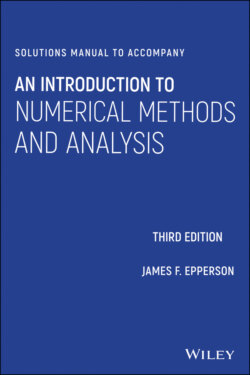Читать книгу Solutions Manual to Accompany An Introduction to Numerical Methods and Analysis - James F. Epperson - Страница 17
2.7 APPLICATION: SIMPLE TWO‐POINT BOUNDARY VALUE PROBLEMS Exercises:
Оглавление1 Solve, by hand, the two‐point BVP (2.28) and (2.29) when , using . Write out the linear system explicitly prior to solution. You should get the following system:Solution: The approximate solution is
2 Repeat the above, this time using . What is the system now?
3 Repeat it again, this time using . What is the system now? (For this problem, you probably will want to use a computer code to actually solve the system.)Solution: The approximate solution is
4 Write a program which solves the two‐point BVP (2.28) and (2.29) where is as given below:;;;.The exact solutions are as given. Using , do we get the same kind of accuracy as in Table 2.10? Explain why or why not.Solution: The approximate solutions will display the kind of accuracy suggested in the text, except for (d); in this case, the singularity in the logarithm function in the solution affects the accuracy of the approximation.
5 Try to apply the ideas of this section to approximating the solution of the two point boundary value problemCan we get a tridiagonal system that Algorithm 2.6 can be applied to? Hint: Consider some of the approximations from §2.2; use the most accurate ones that can be easily used.Solution: Use the approximationto construct the approximation. Using the approximationwill result in a loss of accuracy.
6 Solve the two‐point boundary value problem problemusing a range of mesh sizes, starting with , and going as far as . Comment on your results.Solution: For larger values of , the approximate solution is erratic and wildly oscillatory. It isn't until about or so that the solution begins to settle down.
7 Generalize the solution of the two‐point boundary value problem to the case where and . Apply this to the solution of the problemwhich has exact solutionSolve this for a range of values of the mesh. Do we get the expected accuracy?
8 Consider the problem of determining the deflection of a thin beam, supported at both ends, due to a uniform load being placed along the beam. In one simple model, the deflection as a function of position along the beam satisfies the boundary value problemHere is a constant that depends on the material properties of the beam, is the length of the beam, and depends on the material properties of the beam as well as the size of the load placed on the beam. For a six‐foot‐long beam, with and , what is the maximum deflection of the beam? Use a fine enough grid that you can be confident of the accuracy of your results. Note that this problem is slightly more general than our example (2.28)‐(2.29); you will have to adapt our method to this more general case.Solution: See Figure 2.6.
9 Repeat the above problem, except this time use a three‐foot‐long beam. How much does the maximum deflection change, and is it larger or smaller?
10 Repeat the beam problem again, but this time use a 12‐foot‐long beam.
11 Try to apply the ideas of this section to the solution of the nonlinear boundary value problem defined byFigure 2.6 Exact solution for Exercise 2.7.8.Write out the systems of equations for the specific case of . What goes wrong? Why can't we proceed with the approximate solution?Solution: The problem is that the system of equations that is produced by the discretization process is nonlinear, so our inherently linear algorithm won't work.
